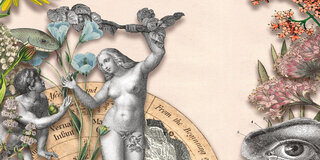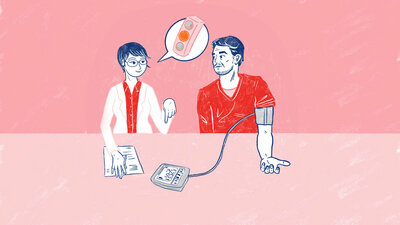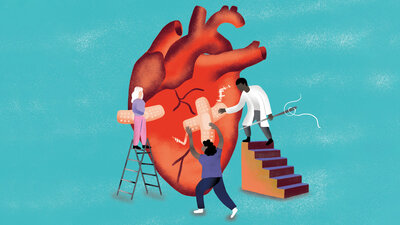Green Medicine - The Healing Powers Of Nature

Naturopathy on the rise: naturopathic methods are more popular today than ever before.
© W&B_MichelleGünther/Getty Images_DigitalVision_duncan1890_ibusca/MauritiusImages_Alamy(3)Memento_Imagebroker_olf
What do nasturtiums, mercury and corona viruses have in common? They are all totally natural! It is not just medicinal herbs, but also strong toxins and the dreaded world-conquering pathogen that come directly from the womb of ‘Mother Nature’. Nevertheless, hardly anything has a more positive ring to it than the simple and plain word ‘natural’.
Professor Michael Siegrist is a research psychologist at the Zurich University of Technology. His field: our preference for the natural, which is not always easy to explain. He conducts his research with the help of chocolate mousse, for example. In an experiment, Siegrist had volunteers taste the exact same chocolaty dessert - with one subtle difference: Some test persons believed that it contained natural vanilla, while the others thought that it was artificial vanilla flavouring. And – no surprise! – the mousse supposedly containing natural vanilla also got the superior evaluations.
Natural = good for us?
‘As soon as something is natural, it seems good to us’, Siegrist argues. ‘We associate it with being healthier, more environmentally friendly and even better in taste.’ A romantic glorification that is particularly well-developed in German-speaking countries, according to the psychologist. And one that we can only entertain since we have largely banished the dangers of nature thanks to science and technology.
Our predilection for the natural becomes particularly obvious when looking at health and illness. Almost every other German has already tried out a naturopathic therapy. Even at the pharmacy counter, one question often pops up: ‘Isn’t there something natural instead?’ But the questions remain: When is medicine actually ‘natural’ - and how effective are these methods?
Kneipp was accused of having hay-flowered and stinging-nettled naturopathy.
In the beginning, there was water. And some broken ribs in 1816: When the young farmer’s son Vinzenz Prießnitz was severely injured after falling off a horse-drawn cart, the doctor who had been summoned gave up on him. But Prießnitz, then just 17 years of age, decided to help himself. In the forests of his Silesian homeland, he had once observed a wounded roe deer seemingly healing itself at a cold spring. The young man dipped cloths in cold water, wrapped them tightly around his chest - and got well again! His miraculous self-healing was to make history. ‘It was the beginning of a spiritual current that later found its stirring and vital expression in the naturopathic movement’, Professor Robert Jütte explains, a medical historian from Stuttgart.
Back to nature: romantic transfiguration
The call ‘back to nature’ became almost commonplace in the middle of the 19th century. It was in the air, so to speak, as the air was becoming increasingly polluted. In the rapidly growing cities, working-class families lived in cramped and damp flats breathing in the smoggy air emanating from the chimneys. The children suffered from rickets and diphtheria, their parents from ‘consumption’, as tuberculosis was still called at the time.
But even those who lived relatively comfortably could hardly keep up with the seven-league boots worn by the Industrial Revolution. ‘Many suffered from a new disease, neurasthenia’, says medical historian Jütte. Those affected were irritable, exhausted, anxious: burnt out by progress. A social movement was born which named itself the ‘life reform’ movement. Its aim was to return to a ‘nature-appropriate way of life’. Some affiliates took it to the extreme, living in communes on home-grown plant food while gardening and dancing naked under the open sky. And, like the writer Hermann Hesse, sometimes they got badly sunburnt.
The zeitgeist also unleashed an unprecedented wave of naturalness in the field of medicine. Around 1850, there were already more than 70 hydrotherapy establishments in Germany. Their heads had studied under Vinzenz Prießnitz at the now world-famous Gräfenberg spa. Competition soon sprouted in many places: At his ‘Jungborn’, the trained bookseller Adolf Just prescribed light and air cures. Muesli inventor Max Oskar Bircher-Benner served crudités even to the King of Siam in his Zurich sanatorium ‘Lebendige Kraft (Lively Energy)’. In the Bavarian town of Bad Wörishofen, the Roman Catholic priest Sebastian Kneipp cured people with water, just like Prießnitz. However, Kneipp also introduced herbal medicine into naturopathy. He was accused of having ‘hay-flowered’ and ‘stinging-nettled’ natural medicine, Jütte recalls.
Scepticism towards modern medicine
The medical establishment reacted cautiously, often even openly hostilely. But that did not halt the success of the movement. Medical lay associations were founded to spread these new ideas. On the other hand, public scepticism grew towards so-called orthodox medicine at the beginning of the 20th century – despite ground-breaking innovations such as the discovery of X-rays. ‘Therapeutic medicine was not very good at that time’, Jütte explains. The accusations sound all-to familiar today: A loss of holism was lamented. The medical view, it was said, was restricted to sick organs and cells. There was talk of a ‘desecration of medicine’.
‘Doctors complained that so-called “quack doctors” were becoming more and more popular’, pharmacist Dr Roswitha Haug reports. She devoted her doctoral thesis to a period of homeopathy and naturopathy the memory of which is often suppressed by the proponents: its short but stellar career in Nazi Germany.
‘The National Socialists promoted naturopathic methods from the very beginning’, says Haug. The price for that was high: unconditional surrender to the ‘blood-and-soil’ ideology of the Third Reich. ‘The only thing on the agenda was the health of the national body, consisting of racially pure workers and soldiers and reproductive women capable of give birth to such [workers and soldiers] for the state’, Haug explains. The ‘New German Heilkunde (healing science)’ was intended to counter ‘Judaised (verjudete)’ orthodox medicine. Under its umbrella, all alternative methods were to be unified, including therapies that originally did not belong to naturopathy, such as homeopathy and the treatment with Schuessler salts. There were enthusiastic reactions from many proponents of naturopathy, who had for so long been defamed.
Terrible experiments in Nazi Germany
The new status was also visible in medical and pharmaceutical journals. ‘The number of advanced training courses in homeopathy and phytotherapy increased significantly’, says Haug. In the course of their studies, pharmacists now learned how to make globules. And the methods of naturopathy were tested – on innocent victims. In the horrifying human experiments in concentration camps, for example. In Dachau, for instance, attempts were made to cure malaria and blood poisoning with Schuessler salts. Without success, not surprisingly.
In Buchenwald, the effect of the herbal remedy Echinacea was tested on painful phosphorus burns. Similarly barbaric experiments were also carried out in hospitals. They tested, for example, whether homeopathic globules were more effective than placebos – dummy drugs without active ingredients. And this was done for serious afflictions such as pneumonia and venereal diseases. Here, too, the results were disastrous. ‘Hitler finally realised that you can’t win a war with water cures and globules’, Jütte summarises.
From the 70s untill today
In post-war Western Germany, naturopathy and homoeopathy were in the shadows at first. In the era of the Economic Miracle, there was a renewed euphoria for progress – also in scientific, ‘orthodox’ medicine, which was able to demonstrate more and more therapeutic successes. The comeback of the alternatives came in the 1970s, when the consequences of environmental pollution once again led to a longing for natural life. Members of the eco-movement bought their wholemeal cereals in health food shops - and once again tried to rely on natural therapies for illnesses.
And today? ‘Orthodox’ medical sciences can now draw on an even bigger repertoire of effective treatments. Nevertheless, naturopathy is more popular than ever before. Its methods have not just found their way into many doctors’ surgeries – but also into some universities. Dr Barbara Koch is deputy head of the outpatient clinic for naturopathy at the renowned Charité research hospital in Berlin. Many of the patients who come here for help are suffering from chronic illnesses like pain, gastrointestinal problems, inflammations such as rheumatism or metabolic disorders such as diabetes. Conventional medicine can often merely alleviate the symptoms. Natural medicine also has no miracle cures on offer. But it helps those affected to find a different way to cope with their illness.
The rise of naturopathy

‘Naturopathy is not an alternative medicine.’ – Dr Barbara Koch.
© W&B/Andreas Müller
‘Naturopathy means: What can I do myself to influence my health, my life and my environment?’, Koch explains. This is done with methods that have in part been proven effective in research studies. ‘We are trying to put natural medicine on a scientific footing’, the specialist for internal medicine adds. Today, the positive effects of exercise and nutrition, such as plant-based diets and fasting cures, are beyond question. The so-called mind-body medicine, which tries to have a healing effect on the entire organism via both psyche and body, has also been proven to have a positive impact upon our quality of life. Traditional methods from the Far East such as yoga, ayurveda and acupuncture are also put to the test. Here, too, with some positive results.
But natural medicine is more than that. When Koch talks about her work, she likes to use terms like ‘we’ and ‘together’: ‘Conversation is very important’, she says. ‘It’s about understanding people and meeting them where they are.’ Affection is also medicine – as scientific studies have shown, by the way. Nevertheless, Koch does not see herself in competition with conventional medicine. ‘Naturopathy is not an alternative medicine’, she opines. Her goal is to incorporate naturopathic elements into every medical treatment.
Not everything is naturopathy
Outside the ivory tower of the universities, things are a lot more colourful when it comes to naturopathy. Infusions with high doses of vitamins and strange autologous blood therapies with UV light irradiation are on offer. ‘That has nothing to do with the original idea of naturopathy’, says medical historian Jütte. Even the most innate methods of yesteryear’s conventional medicine – such as cupping – now go by the name of ‘naturopathy’. Many of these methods have actually not yet been shown to work.
For those seeking help, it is often difficult to tell whether they are doing something good for their health or falling for a modern-day ‘quack’. Because natural medicine is also like the word ‘natural’. Does it have healing powers? Or is it even harmful? To answer these questions, it is simply not enough to trust the melodious sound of a word. As always: What is important is well-founded information and an ever-critical view. Also back into the past.





